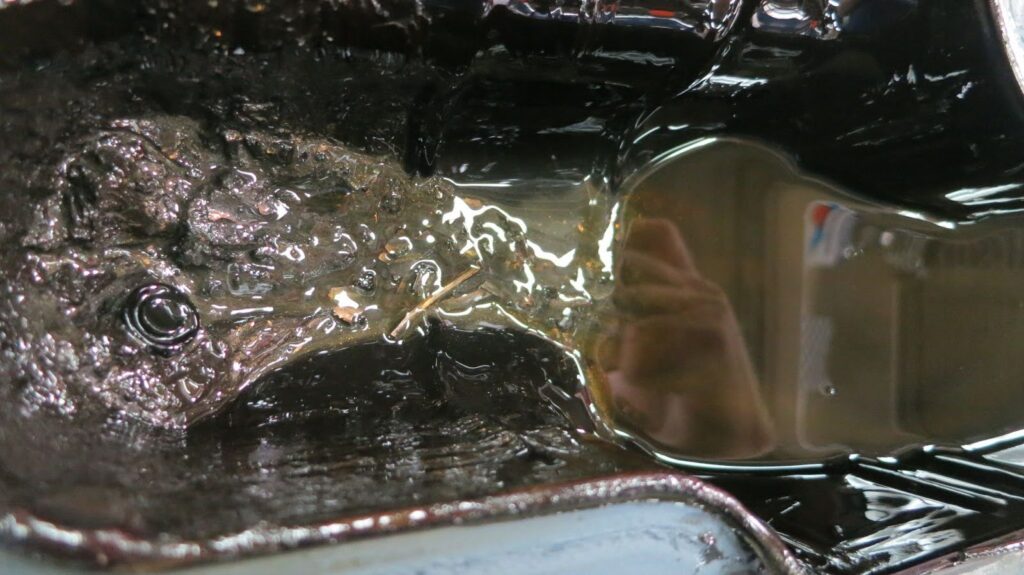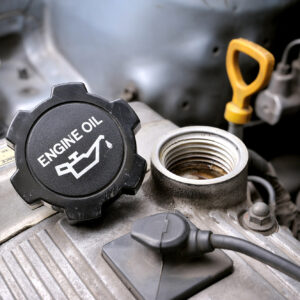Have you noticed metallic specks in your engine oil? While they’re not as alarming as a smoking hood or a strong gas smell, metal shavings in your oil are not a symptom you can ignore.
These tiny particles typically come from worn-out engine components. Luckily, you can prevent their ill effects with proper care and maintenance.
What Are Metal Shavings and Why Are They in My Oil?
Metal shavings in engine oil could indicate wear and tear on engine parts, such as the bearings, camshaft, pistons, and rods. These components get a lot of friction, and when they don’t get enough lubrication, they can degrade and produce metal shavings.
Some oil drain plugs have magnets on them and you may see steel or iron shavings on the plug when you change the oil, but aluminum and brass aren’t ferrous metal and won’t stick to the magnet.
The color of the shavings also varies. Shiny aluminum indicates wear on engine surfaces, while copper or bronze signifies damage to the bearings or bushings. Iron shavings mean problems with the camshaft or the crankshaft.


Is It Normal To Have Metal Shavings in Oil?
Finding metal shavings in oil is normal because engine parts naturally wear down. However, they’re not supposed to be visible. That only happens when an abnormal amount of shavings has built up on magnetized components like the drain plug.
These shavings might also indicate increased or accelerated wear on engine components and could cause irreversible damage.
What Causes Metal Shavings in Oil?
Besides damage to engine components, a damaged oil filter, foreign materials getting into the oil, and lack of engine lubrication could also cause metal shavings in the oil. Usually by the time you see many shavings, it’s too late. Timing chain components can create shavings as well, and this is fairly common in 21st century engine platforms.
Damaged Oil Filter
The oil filter filters out contaminants that accumulate in the oil. It helps keep your engine healthy by preventing tiny particles from wearing down the engine surface.
For the oil filter to let particles, it just about has to be destroyed internally. Oil filters should be replaced at every oil change rather than every other oil change, as some people like to do.
Foreign Contaminants
Metal shavings don’t always come from inside the vehicle. If some bad actor put shavings in your engine through the oil filler you might have them for that reason, but don’t expect that to be the case.
Lack of Engine Lubrication
Motor oil in engines reduces the damaging friction that could hinder performance. If there’s not enough oil, the increased contact between parts can strain the engine, and the heat from the friction can create more metal shavings.
Effects of Metal Shavings in Oil
Metal shavings in oil have ill effects on your vehicle, from hindering the engine’s performance to producing strange noises.
Decreased Power
A decrease in power could mean metal shavings have clogged the oil filter. Oil greases the moving parts of your engine, and a clogged filter can keep the lubricant from going where it needs to.
The oil that gets through the faulty filter is usually contaminated with grime and dirt, which means it’s not that effective in reducing the friction between moving parts. Neglecting the issue could severely damage the engine.
Rough Idling
Rough idling is the excessive shaking and vibrations you feel when the engine is running but not moving. Some of its symptoms include bouncing, shaking, stalling, and backfiring.
There are a handful of probable causes, and the lack of proper lubrication in components is one of them. As mentioned, a clogged oil filter caused by excessive metal shavings means there’s not enough oil to lubricate different parts.

Ticking Noise
Moving engine parts can produce ticking noises when they rub against each other without adequate lubrication.
Engine Knocks
Built-up metal shavings could also result in engine knocks, which are the clunking sounds you hear when accelerating. They occur when the fuel is burning unevenly, likely due to an incorrect balance of air and fuel.
Fuel usually burns in small and regulated pockets before creating a small shock and igniting the next pocket. Knocks happen when the uneven burning makes the shocks go off at the wrong time.
Illuminated Check Engine Light
An illuminated check engine light could mean a handful of things, from something minor like a loose gas cap to severe issues like a damaged engine component.
While it won’t light up to indicate the built-up shavings, it could activate when a lack of lubrication is affecting auto parts.
There are also late-model vehicles with oil pressure or oil pressure change indicators that light up when there are issues with the oil.
How to Prevent Metal Shavings in the Oil
You can prevent metal shavings from getting into the oil by changing the fluid regularly, replacing the oil filter, and repairing damaged parts right away.
Change the Oil Regularly
In addition to removing the built-up metal shavings, regular oil changes improve engine performance and prolong its lifespan. It also helps your car achieve peak gas mileage.
It’s recommended to change the oil every 3,000 miles. There are some cases when you can leave it up to 7,500 miles, but following the 3,000-mile rule is best for keeping your vehicle healthy.
It’s also ideal to change the oil every 12 months if you’re not using your vehicle frequently.
Replace the Filter
It’s recommended to change the oil filter every three to six months or every other oil change. New oil filters do a better job of collecting metal shavings and other contaminants.
Repair Damaged Parts
Besides the oil filter, it’s also worth checking if engine components, such as the bearings, camshaft, pistons, and rods are worn out because of the lack of lubrication. Replacing these parts should help stave off metal shavings and improve vehicle performance.
Where to Get a New Oil Filter for Your Vehicle
After a while, you’re bound to find traces of metal shavings in your engine oil, indicating the need to get a new oil filter.
The good news is that finding a high-quality oil filter is easy when you shop here at CarParts.com. On hand and ready to ship, our OE-grade oil filters were carefully handpicked by industry professionals, so you’re sure to get a filter that gets the job done.
Find the best oil filter for your ride by entering its year, make, and model into our vehicle selector. This will narrow down the catalog to compatible oil filters for your daily driver. For a more personalized shopping experience, you can also use the search filters to find a product according to your preferred brand, price range, quantity, and more.
Never go over budget when you shop from us. All our products come with a low-price and lifetime replacement guarantee, so you don’t have to worry about breaking the bank for your maintenance needs.
Thanks to our strategically located warehouses across the US, we can get your oil filter delivered straight to your doorstep in as fast as two business days.
Don’t miss out on the best deals on the market, and shop for an oil filter today!
Any information provided on this Website is for informational purposes only and is not intended to replace consultation with a professional mechanic. The accuracy and timeliness of the information may change from the time of publication.

































